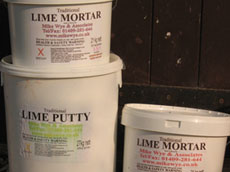Re-pointing with Lime Mortars
Lime is important to building conservation and has been used over many centuries in historic building. We use only lime in mortars and renders as the binder.
Lime mortar offers many advantages over modern cement. Lime mortars are softer and more porous than cement-based mortars. Moisture can therefore evaporate through the mortar rather than through the bricks or stones of a building. Moisture levels in the brick or stone walls do not build up, which in turn prevents the build-up of harmful soluble salts in the masonry. These salts are often the cause of deterioration to the fabric of a building. The signs of this are spalling in bricks and stone.
We tend to use non-hydraulic lime, in putty form, for mortars. It is wise to add ‘pozzolan’ (materials such as dust from soft and low-fired bricks) to assist setting in certain situations. Alternatively hydraulic mortars are sometimes used based on Natural Hydraulic Lime (NHL). The longer a lime putty is left to stand the better. The plasticity of the lime will be improved, therefore improving the bond between a mortar and masonry by resisting suction from the masonry.
A lot of our work involves the replacement of cement mortar with a lime mortar. It is important to rake out the old mortar to a good depth. The use of the correct tools and working with care is vital to prevent damage to the fabric of the building during this raking out process.
It is also important to dampen the joints so that the masonry does not absorb too much moisture from the mortar. This will prevent the lime mortar drying too quickly and maintain the desired strength of the mortar. Care is needed to prevent the lime from smearing and staining the masonry surfaces. The mortar should be as dry as is practical to point with. This allows maximum compaction in the joint, reduces shrinkage cracking and the tendency to smear.
A 3.5:1 mix of coarse sharp sand and lime putty is often used, sometimes with a pozzolan added. The amount of pozzolan added will vary according to the hardness of the masonry and the degree of exposure of a site. The weather and the time of year can also be factors for the type of mortar used. Colour of the mortar is also vital and this is controlled by the type of aggregates, the lime used and the pozzolan.
We use hand made pointing keys or a metal trowel to force the mortar into the joint from a hawk. All cavities most be filled so that no pockets of air remain in the joints. This helps to prevent failure in the mortar.
We monitor the mortar as it is going off, spraying it with a water spray as often as is appropriate to keep it moist. The use of Hessian to keep the wall surface damp and also plastic sheets to keep the sun or wind off the repaired wall are ways to control the drying process and therefore the strength of the mortar.
Once the mortar is green but hard, we use a churn brush to compact the mortar into the joint. This strengthens the mortar and the bond with the masonry. It also provides a traditional and natural finish to the joints, highlighting the aggregates in the mortar and making the work look less new and uniform and therefore more interesting.
